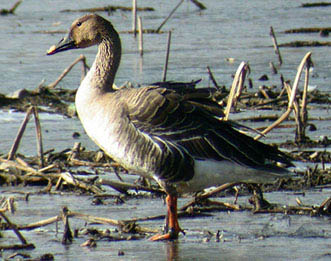Few sounds are more evocative of wetlands than the wild calls of geese. Once a very familiar sound and sight throughout much of Far Eastern Asia, most geese species have declined enormously over the past 150 years or so, as hunting and habitat loss have taken their toll. Although historic data are patchy, most estimates suggest that their populations have declined by well over 90% in the past century, with both Snow Anser caerulescens and Canada Goose Branta canadensis all but lost now as wintering species in Asia. Only two species remain reasonably widespread: the Greater White-fronted A. albifrons and the Bean Goose A. fabalis.

The Bean Goose, comprising two very well-differentiated forms in the region, now numbers only ca 100 000 individuals in total (Miyabayashi and Mundkur, 1999), with nearly 40 000 of these wintering in South Korea (e.g. anon, 1999). Of the two forms of Bean, the Thick-billed or Tundra Bean Goose Anser fabalis serrirostris, which is typically found in rice-fields, is much the more numerous nationally (with the largest flocks along the Han River and at Seosan) while the Eastern Taiga Bean Goose A. f. middendorffi is both more local and more scarce, being essentially confined to well-vegetated lakes and estuaries: a highly threatened habitat type. As a result, Eastern Taiga Bean numbers probably less than 10 000 individuals nationwide, with the majority (ca 6 000 or less in recent winters) confined to the Nakdong River, where flocks move between the three favored sites of Upo, Joonam and the estuary. Recent winter surveys have also discovered several hundred in the Haenam area, 1 650 in the Dongjin estuary (Saemangeum), ca 1 000 at the Geum, and several hundreds at the Han-Imjin estuary (2001: NM pers. data). It is not clear whether these are recently displaced birds from the Nakdong River system, or whether they had been largely overlooked in the past, as flocks in such areas tend to be wary and difficult to observe well.
Apart from their deeper, fuller calls, separation of Taiga from Tundra Bean in Korea is based largely on structure (with differences in bill patterning of little value). The biggest Eastern Taiga Beans have necks up to 30% longer than the smallest Tundra Beans, while their bills are also more swan-like, long and sloping, typically with a flat lower edge to the lower mandible.

Photo © Kim Hyun-tae
These structural differences are key to their ecology, as Eastern Taiga Bean feed almost exclusively in wet mud, digging out the roots of water plants (thus recalling Swan Goose A. cygnoides), while the shorter-necked and -billed Tundra Beans graze in drier habitats on spilt grain and rice stubble, often in the company of Greater White-fronteds.
Their ecological dependence on well-vegetated wetlands makes the Eastern Taiga Bean Goose an especially valuable bio-indicator of complex floodplain and estuarine systems, and as such it has been selected as the logo bird of the Upo Wetland Centre, an organization dedicated to conserving the taxon and its habitat.
As with other key bio-indicator species highlighted on our site's home-page, the conservation of the Eastern Taiga Bean is as important as it is difficult, as it requires the conservation of some of the most important and threatened wetlands in South Korea, including the Nakdong estuary, threatened by a major road bridge, and the Dongjin estuary in Saemangeum, presently undergoing complete reclamation. Rachel Carson wrote so eloquently a human generation ago about “the silent spring”: what an immense loss to us all if autumns and winters were to fall silent too, robbed of the geese and their wild music.
References
- Miyabayashi, Y. and T. Mundkur (1999). Atlas of Key Sites for Anatidae in the East Asian Flyway.
Summary online at: www.jawpg.org. - Anon. (1999) Winter Bird Census 1999. Ministry of Environment, South Korea.



